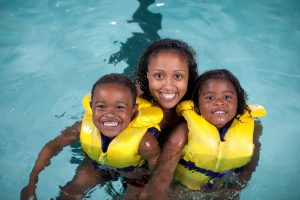 Summertime is here. That means time will be spent at beaches and pools where we can cool off. Here are some important things to know before getting in the water.
Summertime is here. That means time will be spent at beaches and pools where we can cool off. Here are some important things to know before getting in the water.
When around a body of water, there is always a risk of drowning. Drowning only takes a moment and often happens in silence. A child or a weak swimmer can drown in the time it takes to send a text, check a fishing line, or apply sunscreen.
Death and injury from drowning happen every day in home pools and hot tubs, at the beach, or in oceans, lakes, rivers, streams, bathtubs, and even buckets.
Here are some facts and statistics on drowning:
- It is the leading cause of death for children ages 1-4 years old, and the second leading cause of unintentional injury death for children ages 5-14.
- About 40% of drowning deaths among children ages 5-14 occur in natural water like lakes, rivers, or oceans.
- More than half of the fatal and non-fatal drownings among people 15 years or older occur in natural waters.
Drowning can also be non-fatal. Non-fatal drowning can result in long-term health problems and costly hospital stays. Drowning injuries can cause brain damage and other serious outcomes, including long-term disability.
There are steps that you can take to prevent death or injury. Water safety is key, so being water-competent is imperative.
Here are three components of water competency:
- Water Smarts
- Put a fence around your home swimming pool. It should be at least four feet high, fully enclose the pool, and separate from the house. It needs a self-closing and self-latching gate. All toys that might attract a child should be removed when the pool isn’t used.
- Know your limitations, including physical fitness, and medical conditions.
- Never swim alone. Swim with friends or where there are lifeguards or water watchers present. Always wear a life jacket while boating, regardless of swimming skill. Wear a U.S. Coast Guard-approved life jacket appropriate for your weight, size, and water activity. Floaties, armbands, or water wings do not prevent children from drowning and can easily slip off, especially when kids jump in the water. Water wings can produce a false sense of safety for parents and children.
- Swim sober.
- Understand the dangers of hyperventilation and hypoxic blackout.
- Know how to call for help.
- Understand and adjust for the unique risks of the water environment such as:
- River currents.
- Ocean rip currents.
- Water temperature.
- Shallow or unclear water.
- Underwater hazards, such as vegetation and animals.
- Swimming Skills
Swimming lessons can reduce the risk of drowning, but over half of U.S. adults have never taken a swimming lesson. Learn how to perform these five skills in every type of water environment that you may encounter:
- Make sure you can get in and out of the water safely.
- Float or tread water for at least 1 minute.
- Turn over and turn around in the water.
- Swim at least 25 yards.
- Exit the water.
- Helping Others
These actions will help your family and loved ones avoid emergencies – and help you respond if an emergency occurs:
- Closely pay attention to children or weak swimmers in and near the water.
- Knowing the signs that someone is drowning.
- Knowing ways to safely assist a drowning person, such as “reach or throw, don’t go”.
- Knowing CPR and first aid.
It is important to be well-prepared when in and around pools and bodies of water. If you or someone you are with are experiencing an emergency, call 911 immediately.
All content of this newsletter is intended for general information purposes only and is not intended or implied to be a substitute for professional medical advice, diagnosis or treatment. Please consult a medical professional before adopting any of the suggestions on this page. You must never disregard professional medical advice or delay seeking medical treatment based upon any content of this newsletter. PROMPTLY CONSULT YOUR PHYSICIAN OR CALL 911 IF YOU BELIEVE YOU HAVE A MEDICAL EMERGENCY.
